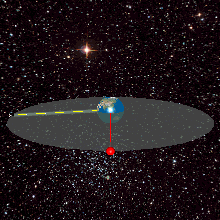
Back قمر اصطناعي متزامن مع الأرض Arabic Satèl·lit geoestacionari Catalan Geostacionární družice Czech Geostationärer Satellit German Satélite geoestacionario Spanish Geostatsionaarne satelliit Estonian ماهواره زمینهمگام Persian Satellite géostationnaire French לוויין גאוסינכרוני HE Satelit Geostasioner ID
This article needs additional citations for verification. (January 2008) |

A geosynchronous satellite is a satellite in geosynchronous orbit, with an orbital period the same as the Earth's rotation period. Such a satellite returns to the same position in the sky after each sidereal day, and over the course of a day traces out a path in the sky that is typically some form of analemma. A special case of geosynchronous satellite is the geostationary satellite, which has a geostationary orbit – a circular geosynchronous orbit directly above the Earth's equator. Another type of geosynchronous orbit used by satellites is the Tundra elliptical orbit.
Geostationary satellites have the unique property of remaining permanently fixed in exactly the same position in the sky as viewed from any fixed location on Earth, meaning that ground-based antennas do not need to track them but can remain fixed in one direction. Such satellites are often used for communication purposes; a geosynchronous network is a communication network based on communication with or through geosynchronous satellites.
© MMXXIII Rich X Search. We shall prevail. All rights reserved. Rich X Search